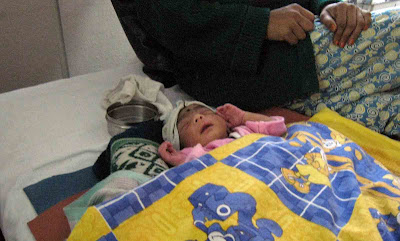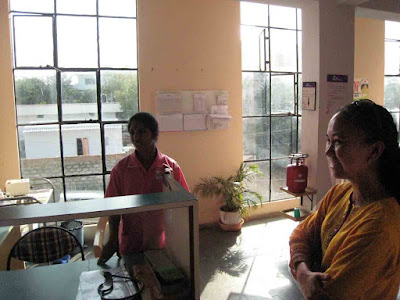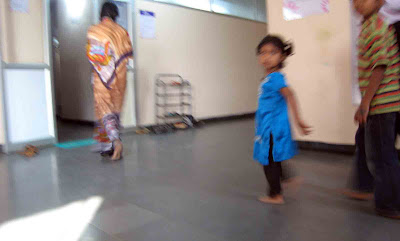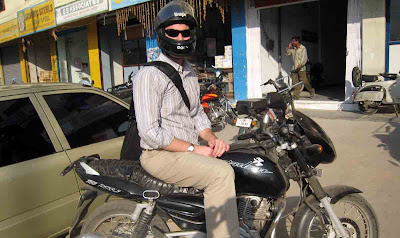Tuesday, January 5, 2010
Wednesday, April 30, 2008
Cricket Hits the Bigtime
 Last Tuesday a group of us attended the first IPL match held in
Last Tuesday a group of us attended the first IPL match held in 
Monday, March 17, 2008
Farm Waivers

Two interesting events the past week in the Indian microfinance space. First off, in what can only be described as a clear vote buying maneuver (a general election is likely later this year) the finance minister, Palaniappan Chidambaram, announced that all loans to farmers with Rs. 50,000 (US$1,250) or more outstanding would be forgiven. The plan, which allocates 60,000 crore (US$15bn) is equivalent to 15% of the entire national budget.
Sunday, March 9, 2008
and back...

Whew, exciting month. Headed back to the states for two weeks to be with my family in
Saturday, February 9, 2008
And then it is all ok...

Found out Wednesday that my Grandad had been diagnosed with cancer. Being separated from family during these times is definitely something I considered before coming over here, but it doesn’t lesson the feeling of just wanting a hug from my dad. Between abbreviated phone calls with family at home it has been a rough few days.

LifeSpring succeeds in offering a valuable service to those at the bottom of the pyramid by being led by a passionate, energetic entrepreneur; a rockstar core management team and a blushingly proud hospital staff “we wouldn’t work anywhere else.”

Being at the hospital and seeing the new parents, seeing their optimism- they are going to raise their children in an

Wednesday, February 6, 2008
Microfinance Gets Rolling in China
Recently there have been signs that microfinance in
Also, I ran across this: a children’s book about microfinance- pretty neat.
Sunday, February 3, 2008
SKS Goes in for a Third Round
 Spandana’s neighbor down the street and competitor/ fellow lender to the poor (will explore this interesting relationship further in a future post,) SKS, has announced the largest equity financing round yet in Indian Microfinance. The deal- amounting to 147 crores (~37.5 million USD) while significant, will likely only be a brief tied over until a further equity infusion is required.
Spandana’s neighbor down the street and competitor/ fellow lender to the poor (will explore this interesting relationship further in a future post,) SKS, has announced the largest equity financing round yet in Indian Microfinance. The deal- amounting to 147 crores (~37.5 million USD) while significant, will likely only be a brief tied over until a further equity infusion is required. Friday, February 1, 2008
Microfinance: The View From Goa

So after a generally very hectic January for most in the industry we got a chance this week to step back from operational goals and re-access the big picture- where will Indian microfinance be in 5 years? I am in the resort town of
Thursday and Friday many of the industry leaders (they didn’t notice me in the back row) in this space gathered for a workshop and two major topics seemed on everyone's mind:
Overall a very productive series of discussions; beaches and balance sheets- I suppose we can't complain too much.
Thursday, January 10, 2008
Ready or Not… The One Lakh Car Arrives

Today Tata announced the arrival of the world’s most inexpensive automobile, smartly named the Nano- for months people have been calling it by its sale price: the 1 lakh car. That works out to approximately $2,500, not bad for a brand new car that looks decent enough and can even keep dry five at a time.
India’s roads are among the world most dangerous; according to this study traffic fatalities per 10,000 vehicles was more then10 times higher then the US (and due to the methodology the real risk might be significantly understated.)
But at the same time
So this all may be a mute point- will the masses give up the efficiency and savings for the comparative comfort and safety of the Nano? Anecdotally, it seems so. In my informal poll, mostly at work where most incomes range between $500 and $1000 per month, there is real enthusiasm. My co-workers, who for the most part are the first generation to leave their rural towns and villages, view car ownership not only as efficient transportation but also a definitive signal of their success. Check back soon as I may be blogging from the backseat of an auto during my hour long commute…

Wednesday, January 2, 2008
What Next for Indian Microfinance?
2007 was a busy year for microfinance. We saw the first IPO- Compartamos in
Thursday, December 27, 2007
Christmas Cheer in Hyderabad
 A crew of us headed out Monday for
A crew of us headed out Monday for

Tuesday evening we all got together for Christmas dinner and drinks, though no substitute for family, we all had a very nice time. I even got to meet Santa!

In some tragic news, Thursday evening the ex-prime minister of Pakistan, Benazir Bhutto was assassinated by suicide bombers after a rally in
Sunday, December 23, 2007
Ford Leans Toward Tata

While I was in Mumbai Friday news came that Ford is heavily leaning toward Tata Group,
Last night we headed out to the
Wednesday, December 19, 2007
The Positive Side of Microlending
The granting to Mohammed Yunus and the Grameen Bank of the 2006 Nobel Peace prize was a dubious honor for the industry; it was the high water mark for a veritable flood of positive PR the industry has received over the past five years. No doubt, the industry has benefited from the exposure, organizations like Kiva, Microplace and Prosper owe their continued support to the popular recognition in the
Is microfinance doing good? In most parts of the world, that is a tentative yes. My hesitancy is primarily due to a lack of credible studies to show the benefit (though this is changing, a study by this group on Spandana is due out in May.) But both anecdotally and theoretically it seems progress is being made. Whenever you increase the supply, as MFI’s do for credit, it reduces the price. This can be seen in villages where MFI’s are active- local moneylenders are forced to charge much lower rates- this is surely good news. Microfinance is no panacea, but slowly, it is helping to improve the lots of many.
On the personal front, I managed to get registered with the foreigners’ office without being extorted for a baksheesh, found an apartment with a guy who works at Acumen Fund- in a section of the city called Banjara Hills, will be nice to get settled in. Am headed off in the morning for Mumbai (
Sunday, December 16, 2007
Welcome to Hyderabad
They didn't mention Saturday is a work day. I got to Hyderabad last Sunday after five fast paced days in Delhi that were spent catching up with a few old friends, gathering as much knowledge as I could on the state of Indian Microfinance from my very patient Lok colleagues; and at a couple of social events getting a chance to meet many expats who are here to work in this exciting country.
As many of you know I interned with Grameen Bank two years ago and had a spectacular time. Since then I have not quite been able to put to rest my keen interest in microfinance and
For the next six months I will be working on the ground, through Lok Capital, with one of their investees, an Microfinance Institution (MFI) called Spandana. I am incredibly excited. They are a top- notch organization comprised of bright, talented people- entirely devoted to helping raise living standards through the extension of financial services. They are as a Lok colleague put it "always trying to build a better mousetrap." When asked, people top to bottom will explain their pride at the organizations ability to cheaply offer highly customized credit to disadvantaged people, and especially Spandana’s operating expense ratio (defined as: Operating Expense/ Average Total Assets.) They are proud for good reason, as operating expense ratio is a rough proxy for the rate of interest they need to charge poor people in order to stay in business.
Share: 9.61%
Basix: 14.71%
SKS: 10.88%
Grameen Bank(
Compartamos (
This can be accredited to the ruthless (though sweet) eye for efficiency of the founder, Padmaja Reddy. An entirely tireless women, she has nurtured Spandana from a small NGO to now the largest MFI in India, by working 80hr weeks and overseeing nearly every aspect of the business.
And so, in a nod to increased efficiency I have learned that for the next half year or so I can look forward to one day off per week. During the course of introductions one of the senior guys quipped [half] jokingly “Tyler, we purposely didn’t tell you about the work schedule until you got here.” Haha, though on a serious note, I think it will work out- the people here are motivated, engaging and generally a joy to work with.
They have some big plans for the next five years, we are going to see if we cant help to put some of the process’s in place so that can happen (introducing a two day weekend is first priority.)
Overall, the process of outsourcing my life has gone rather smoothly. After two very long flights, immigration passed smoothly (I just knew there was going to be some problem with my visa), a taxi was waiting to pick me up at the airport and I was whisked away to a guest house (basically a bed & breakfast) provided by one of the founders of Lok. Lok and Spandana have been a huge help arranging accommodation, getting cell service, and generally finding the things I need. I am currently staying at a guest house that is attached to Spandana’s office, can’t beat the commute.
The food is tremendous.
So, thanks for making it this far. In this column I hope to comment on some of the events that are shaping the fast evolving microfinance space and also share a bit of my experiences in this dynamic, thrilling country. I hope to post 2-3 times per week, so check back every couple of days or so.
On the agenda for this week, get out into the field a bit with Spandana, continue the apartment search, register with the Foreigners office (my first real experience with the dreaded Indian bureaucracy) and hopefully explore some more of bustling
Incidentally, I just came across this very critical look at microfinance published Friday in Business Week, take a look and I will post some of my thoughts soon.

